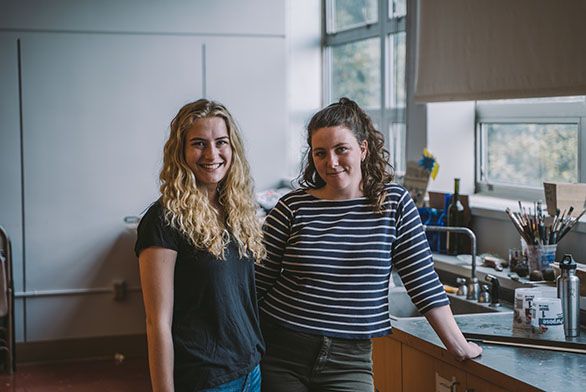Two Students Receive “Garden of Great Ideas” Art Fellowship
May 23, 2019 | By Kimberly Uslin

This summer, rising seniors Julia Cooper (A20) and Anna Seban (A20) will travel to two of the world’s quintessential cultural hubs to study and create art.
The pair are the first students from St. John’s College to participate in the Newington-Cropsey Foundation’s Garden of Great Ideas Fellowship, described in the proposal to St. John’s as “a program by the Newington-Cropsey Foundation Academy of Art which guides students through the process of conceptualizing and completing a sculptural work of art, casted in bronze, which represents or engages meaningfully with one of the Great Ideas from the human history of creation.”
Though this is the first year that St. John’s students will participate, there have been more than 35 Garden of Great Ideas sculptures created by students from College of Charleston, Vanderbilt University, Harvard University, and more. As part of the fellowship, Cooper and Seban will spend June 15 to 28 in New York City and July 1 to 31 in Paris with other participating students. They will develop a journal recording their progress and the evolution of their ideas, which will then be evolved into an artist statement at the conclusion of the project.
“This summer, our task is to make a bronze-cast sculpture that is inspired by or has a theme from the [St. John’s] Program,” says Seban, “turning the Great Books into an art piece that’s going to be displayed on campus for everyone to see.”
Though the details are yet to be solidified, the current plan is to display Seban’s work for half the year and Cooper’s for the other, and as more students undertake the fellowship, to have a rotating piece of art in a (not-yet-determined) designated location on campus.
“To walk on campus and see the Program visually [represented] will help encourage the artists that are already here or the people who are interested in pursuing art to [realize] it can be translated into something visual that isn’t just narrative,” says Cooper. “Like when you see [Diamantini’s] Dido on the Funeral Pyre you’re not just seeing one scene, you’re seeing the whole book in that image. To be able to work with sculpture and build the emotions of the whole book into one [piece] is just really cool.”
“Everybody reads these books differently,” she continues. “Everyone is going to feel something or make different connections with their own experience. Turning something into art is very powerful, because you get to not only see [the artist’s] inspiration, but also everything from the innermost being of the artist that’s going into that piece to make it their own.”
Neither artist is yet sure which part of the Program she will focus on, but Seban is leaning toward a scene from Milton’s Paradise Lost featuring Eve and hopes to create a “living, breathing piece of art” that can interact with nature. Cooper has more of a theme in mind: metamorphosis and the changing emotions and perspectives that can be seen within literary characters.
“The cardinal aims of the Garden of Great Ideas are to celebrate the process of education and to promote the marriage of scholarship and artistry in the service of effective positive cultural revolutions,” explains the proposal. “The Garden of Great Ideas is a tribute to the achievement of mastery and the ultimate interconnectedness of ideas, just as the students’ works are tributes to the synthesis of knowledge and action and the process of being a metaphysical concept into the physical world.”
While in New York, the students will focus on figure drawing and developing the ideas for their pieces, studying at the Newington-Cropsey Foundation Academy of Art in Hastings-on-Hudson with American cast-bronze sculptor Greg Wyatt. They will spend their time in Paris actually creating the bronze-cast pieces using the lost-wax technique, which involves the creation of a model and mold and an intricate casting process. (Once Seban and Cooper’s terms are up, they will be able to keep their pieces.)
Seban traditionally works in cut paper, while Cooper has focused largely on drawing. They admit to being a bit apprehensive about working in sculpture, but feel the Program has prepared them for the challenge.
“It’s an amazing opportunity to be able to take everything that we’ve been working on with the Program as artists already [and expand it],” says Seban. “Everything we’ve been reading has been leaning in that direction. Our art, our annual essays—everything is directed toward beauty and nature, and to be able to have the opportunity to turn that into art, to turn our ideas into something that can be living and breathing just like our books are—it’s really exciting.”
“The lost-wax technique? No one’s learning that anymore,” adds Cooper. “It’s a lost art—pun intended. Paris is the only place left where you can do it. It’s an amazing opportunity, so we want to be ambitious about it, but we don’t want to overshoot it. It’s a little bit scary. We don’t want to do something that we won’t be satisfied with. It’s daunting, but ideally, we’ll come out of this summer and say, ‘That was the best thing we’ve ever done.’”

